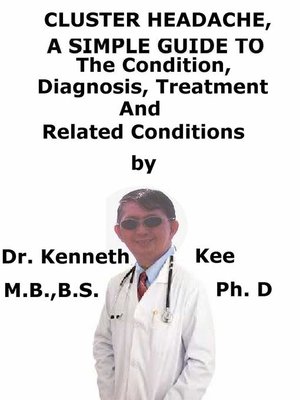Cluster Headache, a Simple Guide to the Condition, Diagnosis, Treatment and Related Conditions
ebook
By Kenneth Kee

Sign up to save your library
With an OverDrive account, you can save your favorite libraries for at-a-glance information about availability. Find out more about OverDrive accounts.
Find this title in Libby, the library reading app by OverDrive.



Search for a digital library with this title
Title found at these libraries:
| Loading... |
This book describes Cluster Headache, Diagnosis and Treatment and Related Diseases
Cluster headaches are severely painful headaches that happen in clusters.
The patient feels cycles of headache attacks, accompanied by headache-free periods.
The incidence of the headaches during these cycles may vary from one headache every other day to several headaches per day.
The pain from cluster headaches can be very severe.
The patient gets a cluster headache when a specific nerve pathway in the base of the brain is activated.
That nerve sensation appears to come from a deeper part of the brain called the hypothalamus, where the "internal biological clock" that controls the sleep and wake cycles lives.
The nerve that is involved, the trigeminal nerve, is accountable for sensations such as heat or pain in the face.
It branches up to the forehead, near the eye, across the cheek, down the jaw line, and above the ear on the same side, too.
An underlying brain disorder, such as a tumor or aneurysm, will not produce these headaches.
There are a few features that distinguish this type of headache.
1. Speed: Cluster headaches normally attain their full force quickly within 5 or 10 minutes.
2. Pain: It is almost always one-sided, and it stays on the same side during a period, the time when the patient is getting daily attacks.
(When a new headache period starts, it might change to the opposite side, but that is infrequent.)
It is often depicted as having a burning or piercing quality.
It may be throbbing or constant.
The patient will sense it behind or around one eye.
It may extend to the forehead, temple, nose, cheek, or upper gum on that side.
The scalp may be tender.
The patient can often sense the blood pulsing.
3. Short duration: Cluster headaches normally only persist 30 to 90 minutes.
They can be as short as 15 minutes or as prolonged as 3 hours but then they disappear.
The patient can probably acquire one to three of these headaches a day.
Some people have as few as one every other day, while others get them up to 8 times a day.
4. Predictable: Attacks appear to be linked to the circadian rhythm, the body's 24-hour clock.
They happen so regularly, normally at the same time each day that they have been called "alarm clock headaches."
They might even wake the patient up an hour or two after the patient goes to sleep.
Nighttime attacks can be more serious than the daytime ones.
5. Frequent: Most people will acquire daily headaches for 2 weeks to 3 months; in between these periods, they will be pain-free for at least 2 weeks.
There are 2 types of cluster headaches
1. Episodic cluster headaches occur regularly between one week and one year, followed by a headache-free period of one month or more.
2. Chronic cluster headaches occur regularly for longer than one year, followed by a headache-free period that lasts for less than one month.
A person who has episodic cluster headaches may develop chronic cluster headaches and vice versa.
The pain from cluster headaches is produced by the dilation, or widening, of the blood vessels that provide blood to the brain and face.
This dilation gives rise to pressure to the trigeminal nerve which passes the sensations from the face to the brain.
Pharmacologic treatment of cluster headache (CH) may be categorized into 2 treatments of cluster headaches :
1. Abortive/symptomatic (e.g., oxygen, triptans, ergot alkaloids, and anesthetics)
2. Preventive/prophylactic (e.g., calcium channel blockers, mood stabilizers, and anticonvulsants)
Galcanezumab is the first drug...






